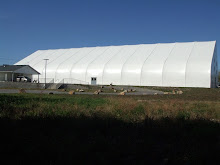


This past weekend we had a very complex Open Jumpers course from Rae Tanner in Lawrence, KS. Not only was the course tricky (and you should have seen the Excellent Jumpers course!) but I had entered both Cala and Zipper. So I was running a 12" dog who is green and runs tight to the handler as well as a 24" dog who runs huge, has her own mind, and often goes off course.
I thought you might enjoy seeing the handling paths I took with each dog. I have a picture of the course alone, then with my handling path with Zipper, then with Cala. With Zipper, my handling path mirrored the dog's path fairly closely, with several rear crosses. With Cala, I stayed much farther away, layering jumps and pulling, doing crosses mostly in the middle.
Zipper Qd, after a single refusal on Jump 3. Cala didn't. I failed to call her verbally between 12 and 13, so she jumped the 2/15 jump instead. At the point when she took that jump, I was still between 11 and 12, that's how much space she uses. However, after I got her back we did finish well.
Every dog has a different comfort zone it works in. In most cases the differences between any two dogs you may run won't be this marked. But when they are, you must walk your course for each dog. In my case, I spent most of my time planning my path for Cala because for me that kind of huge space is challenging. But I still had to plan where I would put crosses for Zipper and how to shape his line for the weaves. I knew that if Cala saw the weaves she'd try to hit them, so worried more about trying to get her to collect a bit so she could hang on to them.
Walking the same course for two very different dogs is similar to having to learn two different courses at the same time. Both are challenging, but both can be done. One thing that panics Novice agility handlers is the very thought of having to memorize two courses. It's a learned skill, just like front crosses and rear crosses. If you are having difficulty learning courses, break them down into components. If competing in AKC, use your provided course map to memorize each course on paper before walking, then walk for shaping your line and handling. I never make handling decisions based on a piece of paper though. The actual course often has a very different feel than what you see on paper. A place that looks wide open on paper may be much tighter on the course, and a place that looked like a trap may be fine.
A course like our Jumpers course is especially challenging because it was all jumps, no tunnels. And lots of weaving back and forth (like I say, you should have seen the Excellent course!) All of us have gotten lost on courses. A good piece of advice once you're out there? Don't look up. Just keep going. If you look up and around, you'll lose concentration and be done for!






